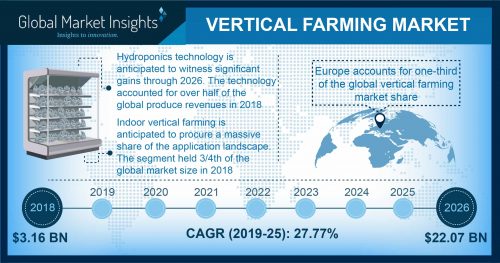Vertical Farming Market Trends 2021; Increasing adoption of aeroponics technology driving demand
Vertical Farming Market is anticipated to witness healthy growth during 2021 to 2027 driven by the increasing environmental degradation and climate change across the globe.

Delaware, United States – July 21, 2021 /MarketersMedia/ —
Vertical Farming Market revenue is expected to gain significant momentum over 2021 – 2027 as a result of the increasing environmental degradation and climate change across the globe. Increasing scarcity of land for farming activities, coupled with the burgeoning global population, is significantly compromising the global food supply and demand, which in turn, pushing the agriculture industry towards vertical farming. As per Global Market Insights Inc. estimates, the global vertical farming market demand is anticipated to surpass $19 billion by 2027.
The demand for vertical farming equipment has been rapidly increasing over the past years, driven specifically by the rising focus on natural resource conservation and recycling to stabilize crop production. As per reliable statistics, there are over 2.2 million sq. ft. of indoor farms operating worldwide, with the number likely to increase tenfold to 22 million sq. ft. over the next five years.
This dramatic rise in indoor farming activities will lead to the production of fresh goods in spaces using reduced natural resources. These factors, alongside the profound potential of vertical farms to ensure food security and sustainability, will expand the scope of the overall industry growth over the coming years.
To access a sample copy or view this report in detail along with the table of contents, please click the link below:
https://www.gminsights.com/request-sample/detail/1525
Below are four key trends that would be outlining the overall industry growth outlook over 2020-2027:
1. Fishing industry’s shift to aquaculture
With growing awareness about wildlife conservation and the uncertain nature of deep-sea fishing, the world has slowly been shifting towards aquaculture to meet its seafood demand. This change is nowhere best apparent than in the tilapia industry.
On the basis of product, the tilapia segment is poised to depict a CAGR of over 23% through 2027, which is attributable to its large size and enhanced taste of the fish. The product prefers a water temperature below 80°F and can be reared in brackish, fresh, and salty water. Moreover, this species of fish has been gaining widespread adoption for aquaponics as its wastewater contains key nutrients required for crop cultivation.
2. Growing prominence of outdoor vertical farming
With regards to the application spectrum, the outdoor segment accounts for nearly 25% of the vertical farming market share. This farming activity can be conducted in high-rise buildings, barren lands, skyscrapers, deserts, and other building structures like retails, restaurants, etc. without the need for pesticides and fertilizers. Extensive R&D activities to increase vertical farming yield in skyscrapers with sunlight and artificial lights will contribute to the rising product popularity over the foreseeable future.
3. Increasing adoption of aeroponics technology
In terms of segmentation by technology, the global vertical farming market from the aeroponics segment will hold an appreciable share in years ahead, owing to its capability to aid the growth of plants in an air or mist environment with the use of minimal water.
The technology has also been gaining high prominence due to myriad benefits such as the requirement of 90% less water unlike hydroponic systems, as well as less space as compared to the conventional farming techniques. The segmental growth can further be propelled by the non-requirement of pest control activities, thus lowering labor costs.
Several other advantages associated with the aeroponics technology include the ability to control moisture for high plant growth, deliver seamless crop harvest as compared to traditional farming and high-quality produce, and reduce labor costs via automation.
4. Strong presence of vertical farmers and industry players in Europe
From a regional perspective, the Europe vertical farming industry is set to exhibit around 20% CAGR through the forecast timeframe, which can be credited to the substantial availability of vertical farming equipment makers and farmers in the region. Recently, Staay Food Group collaborated with Philips and Rijk Zwaan B.V. to establish a 900-m² vertical farm in the Netherlands.
The competitive landscape of the vertical farming market consists of companies such as Spread Co, American Hydroponics, Urban Crop Solutions, General Hydroponics, Mirai Co., Ltd., Plantagon International., Aerofarms, Green Spirit Farm, and Sky Greens, among others. These industry participants are implementing strategies such as product innovations and business expansions to strengthen their market share. To illustrate, in November 2020, Swegreen secured over $1 million in funding from Vinnova to further advance its platform for an AI-driven vertical farming project.
About Global Market Insights, Inc.
Global Market Insights, Inc., headquartered in Delaware, U.S., is a global market research and consulting service provider, offering syndicated and custom research reports along with growth consulting services. Our business intelligence and industry research reports offer clients with penetrative insights and actionable market data specially designed and presented to aid strategic decision making. These exhaustive reports are designed via a proprietary research methodology and are available for key industries such as chemicals, advanced materials, technology, renewable energy, and biotechnology.
Contact Info:
Name: Arun Hegde
Email: Send Email
Organization: Global Market Insights Inc.
Address: 4 North Main Street, Selbyville, Delaware 19975 USA
Phone: 1-302-846-7766
Website: https://www.gminsights.com/pressrelease/vertical-farming-market
Source: MarketersMedia
Release ID: 89037784